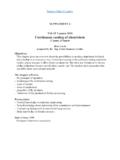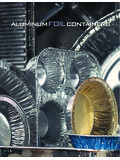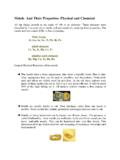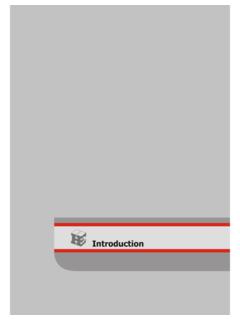Transcription of 1301 The Rolling of Aluminium: the Process and the …
1 SUPPLEMENT 4 TALAT Lecture 1301 The Rolling of aluminium : the Process and the Product24 pages, 29 fi guresBasic Levelprepared by Roy Woodward, aluminium Federation, BirminghamObjectives:- to provide suffi cient information on the Rolling of aluminium and the characteristics of rolled products to ensure that students, users and potential users can understand the production features that affect properties and economics- to show how, in consequence, alloy choice for an end application depends not only on the characteristics required for that end use but also on semi-fabrication :- General knowledge in materials engineering- Some knowledge about aluminium alloy constitution and heat treatmentDate of Issue: 1994 EAA - European aluminium AssociationReturn to Table of ContentsTALAT 1301 21301 The Rolling of aluminium : the Process and theProductTable of contents1301 The Rolling of aluminium : the Process and the Product.
2 Introduction .. Sheet Products .. Plate .. properties of Rolled Products .. List of IntroductionRolled products, sheet, plate and foil constitute almost 50 % of all aluminium alloysused (see Figure ). In North America the packaging industry consumes themajority of the sheet and foil for making beverage cans, foil containers and foilwrapping (Figure ). Sheet is also used extensively in building for roofingand siding, in transport for airframes, road and rail vehicles, in marine applications,including offshore platforms, and superstructures and hulls of boats. Also, whilerelatively little is currently used in the manufacture of high volume productionautomobiles, it is expected that the next decade will see sheet used for both spaceframes and body panels, a market that could easily match the 2 million tons now usedfor beverage cans.
3 Plate is used for airframes, military vehicles and bridges, shipssuperstructures, cryogenic and chemical vessels and as tooling plate for the productionof plastic products. Foil applications outside packaging include electrical equipment,insulation for buildings, lithographic plate and foil for heat exchangers (this lecturedeals only with sheet and plate).aluTraining in aluminium Application TechnologiesBUILDINGCONTAINERS & PACKAGING 22%ELECTRICAL 10%TRANSPORTATION 23%OTHERS 24%& CONSTRUCTION 21%By END-USE MARKETSHEET, PLATE & FOIL 43%EXTRUSIONSROD, BAR & WIRE 7%CASTINGS 21%OTHERS 4%25%By PRODUCTNORTH AMERICA 34%SOUTH AMERICAPACIFIC 29%EUROPE, AFRICA& MIDDLE EAST 33%4%By REGIONW estern World Shipments of aluminium 1301 3 This wide range of products demands combinations of properties that span the wholerange available from the aluminium alloy portfolio (see also TALAT lecture ), high strength, good corrosion resistance, good formability, good machinability, hightoughness, good ballistic performance etc.
4 (Figures and ) Alsosince in many cases the materials with which the aluminium alloys compete arerelatively low cost, for example tin-plate, paper, wood, mild steel and plastics, it isessential that the cost of the aluminium products are themselves as low as possible,consistent with the achievement of the required properties . Since the cost of smeltingaluminium is unlikely to be further reduced to any degree it is, therefore, essential thatsemi-fabrication costs are kept to a in aluminium Application TechnologiesCANSOTHER PACKAGINGROAD VEHICLESRESIDENTIAL SIDINGOTHER BUILDINGAIR CONDITIONERS / APPLIANCESHOUSEHOLD & FOILAIRCRAFT PLATEAIRCRAFT SHEETCOOKING UTENSILSLITHOGRAPHIC SHEETMOBILE HOMES2,01336129819015514013311096505035K TONNESS ource: Aluminum Association1990 Sheet, Plate & Foil Markets by Product Type(N.)
5 America) in aluminium Application TechnologiesWELD ABILITYYIELD STRENGTHMODULUSSTRESS PROPERTIESAlAl-MnAl-Mg-SiAl-Mg-Si-MnAl-Z n-Mg-CuAl-Li-Mg-CuAl-Mg-Si-CuAl-Zn-MgAl- Mg (3%)Al-Mg (5%)CAN BODIES(3004)CAN END(5182)GAS CYLINDERS(6082)PRESSURECABIN(2024)FATIGU EUTSAIRCRAFTMILITARYSTRUCTURESROAD & RAILTRANSPORT, MARINE STRUCTURES,CRYOGENICSDECORATIVE,CONTAINE RS, CANS,ELECTRICAL,COOKING UTENSILSAUTOMOBILER ange of properties and Uses of aluminium 1301 4 All aluminium alloys can be rolled to sheet but, with a few notable exceptionsmentioned below, the ones utilised are from the 1000, 3000 and 5000 series which arework hardening alloys (Figure ). However, the 2000, 7000 and 8000 heattreatable alloys are used for airframes, 2000 and 6000 series for automobiles and the6000 series for some pressure vessels and containers.
6 Examples exist for the use of platein all alloys while foil is almost all from the 1000 series. Figure showssome typical alloys used for specific end-use applications. (As indicated in otherlectures, while there are some 300 different wrought aluminium alloys, probably 80 %of the applications are covered by perhaps 30 alloys).aluTraining in aluminium Application TechnologiesREQUIRED CHARACTERISTICALLOYING ELEMENTPRODUCTLOWER MELTING POINTINCREASED CONDUCTIVITYINCREASED ELASTIC MODULUSDECREASED DENSITYSTRESS CORROSION RESISTANCESACRIFICIAL CORROSIONVACUUM BRAZING RESPONSERESPONSE TO CHEMICAL orELECTROCHEMICAL TREATMENTSiBLiLiCr, Zr, AgZnMgSi, Cu, CrBRAZING SHEET, FOILCONDUCTOR STRIPAEROSPACE SHEETAEROSPACE SHEETAIRCRAFT SHEETHEAT EXCHANGERSCLAD PRODUCTSHEAT EXCHANGERSDECORATIVE APPLICATIONSSome Alloying Elements Employed to Give Special Mg-MnAL-MgAL-Zn-MgAl-Zn-Mg-CuAL-CuAL-Cu- MgAL-Mg-Si-MnAL-Li-Cu-MgWORKHARDENINGALL OYSPRECIPITATIONHARDENINGALLOYSMnMgZnCuS iLialuTraining in aluminium Application Technologies1000 ALMain Alloy Types Available as Sheet and 1301 5aluTraining in aluminium Application TechnologiesALLOYAPPLICATIONWORK-HARDENI NG ALLOYS106011003003, 30045005, 50505052, 56575085, 50865454, 54565182, 535622192014, 20246061, 60636082, 63516009, 60107004, 70057019, 70397075, 7079,7050, 7010,7150 CHEMICAL EQUIPMENT, UTENSILS, DECORATIVE EQUIPMENT, STORAGE TANKS, BEVERAGE CAN TRIM, ARCHITECTURAL STRUCTURES, STORAGE TANKS, RAIL VESSELS, ARMOUR TANKS.
7 BEVERAGE CAN TEMPERATURE (eg high speed aircraft).AIRFRAMES, AUTOBODY STRUCTURES, HEAVY ROAD TRANSPORT, RAIL CARS,AUTOBODY , ARMOUR PLATE, MILITARY , TOOLING TREATABLE ALLOYST ypical Applications of some aluminium Sheet & Plate Alloys starting stock for most rolled products is the DC (Direct Chill semi-continuous cast)ingot (see Figure ). The size of the ingot depends on the size of the DC unitavailable, the hot Rolling mill capacity, volume required for a particular end use and tosome extent the alloys being cast. Ingots up to over 20 tons in weight, 500 - 600 mmthick, 2000 mm wide and 8000 mm long are in aluminium Application 1301 Sheet ProductsThe DC ingot is usually cooled after casting to room temperature and then re-heated toaround 500 C prior to successive passes through a hot Rolling mill where it is reducedin thickness to about 4 - 6 mm (Figures and ).
8 The temperatureof pre-heat of the ingot and the time held at that temperature is important for somealloys since a Process of homogenisation takes place which renders the material in thebest condition for Rolling and the achievement of subsequent properties . The strip fromthe hot Rolling mill is coiled for transport to the cold mill which might be on the samesite or elsewhere. Cold mills, in a wide range of types and sizes are available; some aresingle stand, others 3 stand and some 5 stand (Figures and ).Cold Rolling speeds vary but modern mills operate at exit speeds as high as 3000 m perminute. A modern complex including melting furnaces, DC casting facilities, pre-heatfurnaces, hot mill, cold mill and annealing furnaces involves a very large capitalinvestment which can only be fully justified on financial grounds if a big market isassured.
9 Obviously, if such facilities are not fully utilised the economic viability isthreatened. As indicated above, however, hot mill coil can be obtained for furtherreduction in cold mills of lower capacity/speed/ in aluminium Application TechnologiesINGOT480 - 580 C600 mm thicknessREVERSINGBREAKDOWNANDFINISHINGM ILLaluCOILER280 - 350 C5 - 8 mm thicknessSingle Stand Hot 1301 7aluTraining in aluminium Application TechnologiesINGOT500 - 600 C 600 mmREVERSINGBREAKDOWNMILLCOILER250 - 350 C - mm400 - 500 C 20 - 30 mmTANDEM MILLRE-ROLLCOILC onventional Breakdown Mill / Hot Tandem Mill in aluminium Application TechnologiesREVERSINGCOLDMILLCOILER/ DE-COILERCOILER/ Stand Reversing Cold MillAlthough most sheet is produced by conventional hot mills, some considerable efforthas been made by aluminium producers in the United States.
10 Canada and Europe toreduce both the capital and production costs by the development of continuous stripcasting methods (Figure ) whereby hot metal is poured into some form ofstrip caster, thus eliminating the DC casting and hot break-down mills ( ). To date, however, only a limited range of alloy compositions can beproduced in this way with end uses found mainly in foil and building 1301 8aluTraining in aluminium Application TechnologiesREVERSING COLD MILLSCOILER/ DE-COILERCOILER/ Stand Reversing Cold MillaluTraining in aluminium Application Technologies420 - 460 C 20 - 30 mmTWIN BELTCASTERCOILER180 - 250 C 2 - mm380 - 410 C 12 - 15 mmTANDEM MILLTWO STANDTWO-HIGHCOMPACTIONMILLHOT LIQUIDMETAL Strip Casting LineFinal sheet properties for the work hardening alloys in the 1000, 3000 and 5000 seriesare achieved either by temper Rolling or temper annealing.








